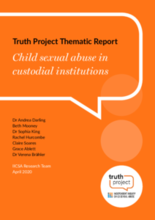Introduction
The Truth Project is a core part of the Inquiry, alongside public hearings and research. It was set up to hear and learn from the experiences of victims and survivors of child sexual abuse in England and Wales. It offers victims and survivors an opportunity to share experiences of child sexual abuse. By describing their experiences, Truth Project participants make an important contribution to the work of the Inquiry. With the consent of participants, the Inquiry uses Truth Project information in a variety of ways, including for ongoing research and data analysis carried out by the Inquiry’s Research Team.
This is the third research publication in a series of thematic reports examining the experiences of victims and survivors of child sexual abuse as shared with the Truth Project. It details the research findings in relation to experiences of abuse in custodial institutions.
A range of terminology is used throughout this report to describe the types of custodial institutions in which children have been held both in the past and currently. The names and terms used for such institutions have changed over the years. This report uses the term ‘custodial institutions’ to describe establishments in operation for children and young people in the youth justice system in England and Wales, both in the past and currently. Nowadays, such institutions tend to be collectively known as the ‘youth secure estate’.
The youth secure estate, and the legislation, policy and practices relating to it, have been subject to considerable change over the years. These changes have shaped the focus of the youth justice system, in particular the evident shift between punishment and welfare responses to children and young people who offend (Bateman, 2011; Bottoms and Kemp, 2007; Williams, 2004; Hagell, Hazel and Shaw, 2000). Developments since the mid 1980s have been shaped by identified safeguarding failures and concerns about the welfare of children in custody.
Although there have been some successes, more recent reviews have continued to highlight the need for further progress in the youth secure estate (Brooks et al., 2019; Taylor, 2016). Work within the Inquiry to date has also identified a number of continuing issues. For example, the Inquiry’s recent investigation report Sexual Abuse of Children in Custodial Institutions: 2009–2017 highlighted the shocking decline of safety in the secure estate in recent years, and concluded that children in young offender institutions and secure children’s homes are still not safe from harm, either sexual or physical. The Inquiry’s research study exploring recent perceptions and experiences of safeguarding in the youth secure estate (published in the report Safe inside? Child sexual abuse in the youth secure estate) also found that children in the youth secure estate did not always feel safe or protected from harm, and that work is still required to develop the culture around safeguarding within custodial institutions.
This report describes the experiences of Truth Project participants who told us they were sexually abused in custodial institutions between the 1950s and 2010s, with the most recent case in our sample beginning in the early 2010s.
The information analysed in this thematic report was provided by victims and survivors who came to the Truth Project between June 2016 and January 2020. The analysis was undertaken by members of the Inquiry’s Research Team between September 2019 and January 2020.
In particular, the analysis aims to address research questions concerning:
● the nature of child sexual abuse experienced by participants in custodial institutions;
● what, if anything, could have been done to prevent the abuse;
● how much the institutions knew about the abuse at the time;
● victims and survivors’ experiences of disclosing the abuse and of the responses;
● barriers and facilitators for disclosure;
● the impacts of child sexual abuse in custodial institutions; and
● victims and survivors’ suggestions to improve the protection of children in the youth secure estate in future.
This thematic report complements the Research Team’s rapid evidence assessment into child abuse in custodial institutions (Mendez Sayer et al., 2018), their primary research into perspectives on child sexual abuse in the youth secure estate (Soares et al., 2019b), and the Inquiry’s investigation into child sexual abuse in custodial institutions (Jay et al., 2019).

